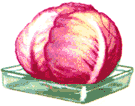



The juices of some vegetables and other plants will work as litmus test indicators for acids and bases. Red cabbage is cooked until it is tender, and its juice is strained into a jar. When a little of this juice is added to an acid, such as vinegar, it will become redder; in a base, such as ammonia, it will turn towards blue or green. Beet juice will also react in this way, but not quite so well as the cabbage.
The spice turmeric will turn from yellow to red when a bit of the powder is added to a base.
Indicators are usually more reactive if they are made by the "alcohol" method. With cabbage, for example, shred the leaves and cover them with rubbing alcohol. Let stand until the alcohol has become a deep red. Strain out the cabbage leaves. When an acid is added, the red color will deepen. If a base is added, it should turn green.
Other plant juices such as cherries, beets, and blueberries work as well. A reader, Thomas Castagno, writes that the leaves of the poinsettia (toxic!) and carnation flowers will also work.

This article was printed from the Bizarre Labs website at bizarrelabs.com